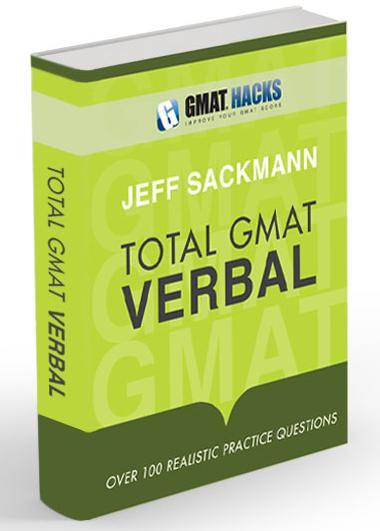
Bookshelf
|
|
Total GMAT Math Jeff's complete Quant guide, on sale now! |
|
|
Total GMAT Verbal Everything you need to ace GMAT Verbal! |
1,800 Practice Math Questions
Buy Jeff's books at Amazon.com

GMAT Official Guide, with IR
OG Math | OG Verbal
OG12 & Quant Rev solutions!
GMAT Question of the Day
Beginner's Guide to the GMAT
GMAT Hacks Affiliate Program

Recent Hacks

Categories
- General Study Tips
- Goals and Planning
- CAT Strategy
- The Mental Game
- GMAT Math Strategy
- GMAT Math Topics
- Mental Math
- Data Sufficiency
- Critical Reasoning
- Reading Comprehension
- Sentence Correction
- Analytical Writing Assessment
- Integrated Reasoning
- IR Explained
- Business School Admissions
- GMAT Prep Resources
- Practice Questions
- Total GMAT Math
- Total GMAT Verbal
- GMAT 111

A Small Improvement Can Be a Dangerous Thing
| You should follow me on Twitter. While you're at it, take a moment to subscribe to GMAT Hacks via RSS or Email. |
I often meet with clients who need a small boost in their GMAT score. Perhaps they recently took the test and got a 670, but feel they need a 700. It seems easy enough–a little more elbow grease, some better advice, and the job is done.
Not so fast.
Sometimes this is the case. However, getting a better grasp on the content–especially on difficult GMAT math concepts such as probability, overlapping sets, and combined rate-can lead to a whole different set of pitfalls.
The Clock is Ticking
As I write just about every week in some context or other, the GMAT is a thinking skills test, not a content test. One of the ways it tests your thinking skills is to put you under pressure to determine whether you can allocate your time appropriately. If you've been scoring in a certain range–say, 650 or so–you've probably gotten accustomed to doing that level of problem in the proper amount of time.
However, if you improve, even if that means getting two or three more questions right over the course of an entire section, the problems you see will be harder. They won't be impossible, and you may even immediately recognize them as more difficult.
Therein lies the rub.
The better you get at GMAT questions–especially math–the more you'll get into a spirit of figuring things out. When you know all the rules and formulas, math can be fun, at least in the sense that it's satisfying to find the answer. But when you get to, say, question #11 on the GMAT Quantitative section, your goal isn't to find an answer to #11 at all costs, it's to get the best possible score on the section–which includes watching the clock.
How to Avoid This Problem
First, when you learn new concepts, make sure you know them inside and out. It's better to learn 100% of one concept than 50% each of two different ones. That way, if you see a problem that falls into one of the areas you've recently studied, you'll know how to do it.
The danger you want to avoid is seeing a problem that looks familiar, but you don't know how to approach. The sort of problem that, two weeks ago, you might not have had a clue on, but now you...have a clue. Just a hint. Those are the problems that get you working them out on paper with no end in sight.
Second, take care not to try too many things on any single question. If you approach each problem confidently, you may have time to try (and fail) with one approach. Then, if you come up with the correct method, you still have time to work through the question that way.
What you most certainly don't have time to do is to try several different methods. By the time you're taking a second approach, you should realize that you don't really know how to do the problem. Perhaps you'll get lucky, but there's absolutely no point in spending four or five minutes on a question you'll probably get wrong anyway.
Third, err on the side of skipping (guessing) too much. I always tell my clients to approach the test as if they have three to five "Get Out of Jail Free" cards. If you see a question that baffles you–whether because it's completely unfamiliar, or you're just afraid it will take too long–skip it! Don't spend your two minutes trying to figure it out, just move on and save yourself the stress!
Of course, you don't want to skip your way through half the test. But strategically used, taking no more than thirty seconds and making an educated guess can save you time for the problems you do have the confidence to approach. In that way, you can take advantage of your small improvements and avoid the potential dangers of them.
About the author: Jeff Sackmann has written many GMAT preparation books, including the popular Total GMAT Math, Total GMAT Verbal, and GMAT 111. He has also created explanations for problems in The Official Guide, as well as 1,800 practice GMAT math questions.
 |
Total GMAT Verbal
The comprehensive guide to the GMAT Verbal section. Recognize, dissect, and master every question type
you'll face on the test. Everything you need, all in one place, including 100+ realistic practice questions. |